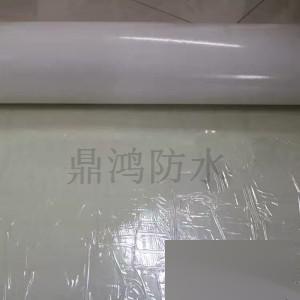Polymer self-adhesive membrane (non-asphalt-based) waterproofing membrane is specially developed for underground and tunnel projects. It is designed to form a strong anti-adhesion waterproof membrane that bonds with cast-in-place concrete structures. This membrane is primarily made of resin-based polymers (such as EVA, LDPE, HDPE, ECB, etc.) and is a polymer self-adhesive waterproof membrane with a self-adhesive layer on top of the polymer waterproof substrate. The self-adhesive layer and the protective layer against environmental changes have self-healing capabilities, and after reacting and solidifying with liquid concrete, they form a seamless bond between the waterproof layer and the concrete structure, eliminating the risk of water seepage and effectively enhancing the reliability of the waterproof system.

Product Features of Polymer Self-Adhesive Membrane
1. Unique formulation, non-asphalt-based reactive pre-applied polymer self-adhesive waterproof membrane is composed of non-asphalt-based self-adhesive materials combined with polymer sheets.
2.Suitable for pre-applied anti-adhesion waterproof projects in underground and tunnel engineering, with impact resistance that allows for direct tying of rebar and pouring of concrete after the waterproof layer is completed without the need for a protective layer.
3.The polymer self-adhesive membrane (non-asphalt-based) waterproof membrane has unique bonding properties, with peel strength 2-3 times that of ordinary self-adhesive membranes.
4.Good low-temperature flexibility, maintaining excellent flexibility even at -30℃.
5.Reliable waterproofing performance, combining the advantages of both polymer waterproof membranes and self-adhesive membranes.
6.The waterproof membrane is laid loosely on the substrate and is not affected by substrate settlement or deformation.
7.Low substrate requirements, saving construction time, as there is no need for cement-sand leveling of the substrate; it can be applied on damp surfaces; no treatment of the underlying and base layers is required, and the construction is not affected by weather conditions, saving time and reducing project costs.
8.High tear resistance, reliable waterproofing and impermeability, strong resistance to hydrolysis.
9.Simple and quick construction, flexible and diverse construction methods, with the ability to produce wide widths according to actual needs, resulting in fewer overlaps, faster construction, lower consumption, and reduced costs; construction methods such as loose laying and mechanical fixation can be chosen based on site conditions for more flexible construction and better waterproofing effects.
10.Green, environmentally friendly, and safe; there is no need for solvents and fuels during construction, avoiding the environmental pollution and fire hazards associated with them, and saving energy.













